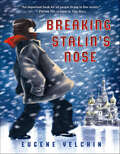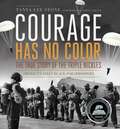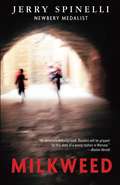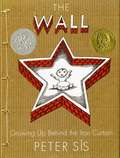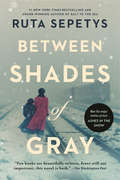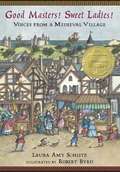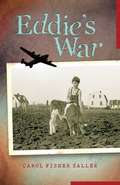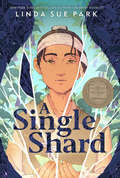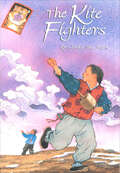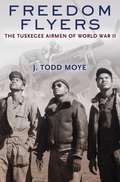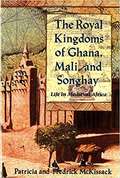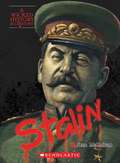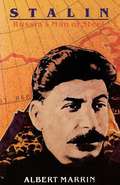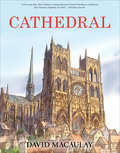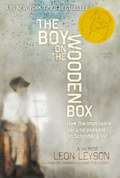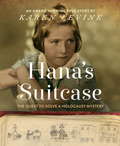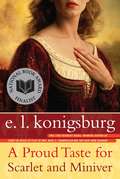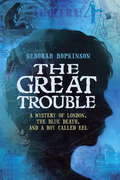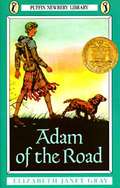Special Collections
District List: BCPS Supplemental Texts - Grade 7
Description: Baltimore City Public Schools Supplemental Text List for students in 7th Grade. #bcps
- Table View
- List View
Breaking Stalin's Nose
by Eugene YelchinSasha Zaichik has known the laws of the Soviet Young Pioneers since the age of six: The Young Pioneer is devoted to Comrade Stalin, the Communist Party, and Communism. A Young Pioneer is a reliable comrade and always acts according to conscience. A Young Pioneer has a right to criticize shortcomings. But now that it is finally time to join the Young Pioneers, the day Sasha has awaited for so long, everything seems to go awry. He breaks a classmate's glasses with a snowball. He accidentally damages a bust of Stalin in the school hallway. And worst of all, his father, the best Communist he knows, was arrested just last night. This moving story of a ten-year-old boy's world shattering is masterful in its simplicity, powerful in its message, and heartbreaking in its plausibility.
Courage Has No Color
by Tanya Lee StoneA 2014 YALSA Excellence in Nonfiction Finalist. They became America's first black paratroopers. Why was their story never told? Sibert Medalist Tanya Lee Stone reveals the history of the Triple Nickles during World War II. World War II is raging, and thousands of American soldiers are fighting overseas against the injustices brought on by Hitler. Back on the home front, the injustice of discrimination against African Americans plays out as much on Main Street as in the military. Enlisted black men are segregated from white soldiers and regularly relegated to service duties. At Fort Benning, Georgia, First Sergeant Walter Morris's men serve as guards at The Parachute School, while the white soldiers prepare to be paratroopers. Morris knows that for his men to be treated like soldiers, they have to train and act like them, but would the military elite and politicians recognize the potential of these men as well as their passion for serving their country? Tanya Lee Stone examines the role of African Americans in the military through the history of the Triple Nickles, America's first black paratroopers, who fought in a little-known attack on the American West by the Japanese. The 555th Parachute Infantry Battalion, in the words of Morris, "proved that the color of a man had nothing to do with his ability. " From Courage Has No Color What did it take to be a paratrooper in World War II? Specialized training, extreme physical fitness, courage, and -- until the 555th Parachute Infantry Battalion (the Triple Nickles) was formed -- white skin. It is 1943. Americans are overseas fighting World War II to help keep the world safe from Adolf Hitler's tyranny, safe from injustice, safe from discrimination. Yet right here at home, people with white skin have rights that people with black skin do not. What is courage? What is strength? Perhaps it is being ready to fight for your nation even when your nation isn't ready to fight for you.
Milkweed
by Jerry SpinelliHe's a boy called Jew. Gypsy. Stopthief. Runt. Happy. Fast. Filthy son of Abraham. He's a boy who lives in the streets of Warsaw. He's a boy who steals food for himself and the other orphans. He's a boy who believes in bread, and mothers, and angels. He's a boy who wants to be a Nazi some day, with tall shiny jackboots and a gleaming Eagle hat of his own. Until the day that suddenly makes him change his mind. And when the trains come to empty the Jews from the ghetto of the damned, he's a boy who realizes it's safest of all to be nobody. Newbery Medalist Jerry Spinelli takes us to one of the most devastating settings imaginable-- Nazi-occupied Warsaw of World War II-- and tells a tale of heartbreak, hope, and survival through the bright eyes of a young orphan. "From the Hardcover edition. "
The Wall
by Peter SísThrough journals, maps, and dreamscapes, Peter Sís shows what life was like for a child who loved to draw, proudly wore the red scarf of a Young Pioneer, stood guard at the giant statue of Stalin, and believed whatever he was told to believe. But adolescence brought questions. Cracks began to appear in the Iron Curtain, and news from the West slowly filtered into the country. Sís learned about beat poetry, rock 'n' roll, blue jeans, and Coca-Cola. He let his hair grow long, secretly read banned books, and joined a rock band. Then came the Prague Spring of 1968, and for a teenager who wanted to see the world and meet the Beatles, this was a magical time. It was short-lived, however, brought to a sudden and brutal end by the Soviet-led invasion. But this brief flowering had provided a glimpse of new possibilities- creativity could be discouraged but not easily killed. By joining memory and history, Sís takes us on his journey: from infant with paintbrush in hand to young man borne aloft by the wings of his art.
Winner of the Sibert Medal
Between Shades of Gray
by Ruta SepetysLina is just like any other fifteen-year-old Lithuanian girl in 1941. She paints, she draws, she gets crushes on boys. Until one night when Soviet officers barge into her home, tearing her family from the comfortable life they've known. Separated from her father, forced onto a crowded and dirty train car, Lina, her mother, and her young brother slowly make their way north, crossing the Arctic Circle, to a work camp in the coldest reaches of Siberia. Here they are forced, under Stalin's orders, to dig for beets and fight for their lives under the cruelest of conditions.Lina finds solace in her art, meticulously-and at great risk-documenting events by drawing, hoping these messages will make their way to her father's prison camp to let him know they are still alive. It is a long and harrowing journey, spanning years and covering 6,500 miles, but it is through incredible strength, love, and hope that Lina ultimately survives. Between Shades of Gray is a novel that will steal your breath and capture your heart.
Good Masters! Sweet Ladies! Voices From a Medieval Village
by Laura Ann SchlitzStep back to an English village in 1255, where life plays out in dramatic vignettes illuminating twenty-two unforgettable characters.
Maidens, monks, and millers’ sons — in these pages, readers will meet them all. There’s Hugo, the lord’s nephew, forced to prove his manhood by hunting a wild boar; sharp-tongued Nelly, who supports her family by selling live eels; and the peasant’s daughter, Mogg, who gets a clever lesson in how to save a cow from a greedy landlord. There’s also mud-slinging Barbary (and her noble victim); Jack, the compassionate half-wit; Alice, the singing shepherdess; and many more. With a deep appreciation for the period and a grand affection for both characters and audience, Laura Amy Schlitz creates twenty-two riveting portraits and linguistic gems equally suited to silent reading or performance. Illustrated with pen-and-ink drawings by Robert Byrd — inspired by the Munich-Nuremberg manuscript, an illuminated poem from thirteenth-century Germany — this witty, historically accurate, and utterly human collection forms an exquisite bridge to the people and places of medieval England.
A Newbery Award book.
Eddie's War
by Carol SallerWorld War II. Hitler is threatening to take over the world. Eddie Carl thinks America should stop him—it’s just plain right. But Eddie’s just a kid, and the farm in Ellisville, Illinois, is a long way from the fighting.
Ellisville: where the big news stories are gophers in the graveyard and the new bank alarm. But then America joins the war and Eddie’s brother Thomas goes off to fly a bomber. Suddenly the war doesn’t seem so far away. And Eddie faces more grown-up problems at home: A fire at the Strothers’ place, and his gypsy friend accused of arson. Grampa Rob, all stubborn and mean. Grama Lucy with her secrets. And that redhead Sarah, who definitely likes him—unless maybe she hates him. Somehow Eddie’s in the middle of it all, trying to figure out what’s right. Let Thomas fight World War II. Eddie’s war is right here in Ellisville.
Eddie’s War is a lyrical collection of prose vignettes linking Eddie, his family, and a small-town cast of Ellisvillians. Poignant and funny, this World War II story tells how a distant war affects the life of one boy in the Heartland.
Traveling Man
by James RumfordIbn Battuta was the traveler of his agethe fourteenth century, a time before Columbus when many believed the world to be flat. Like Marco Polo, Ibn Battuta left behind an account of his own incredible journey from Morocco to China, from the steppes of Russia to the shores of Tanzania, some seventy-five thousand miles in all. James Rumford has retold Ibn Battuta’s story in words and pictures, adding the element of ancient Arab mapsmaps as colorful and as evocative as a Persian miniature, as intricate and mysterious as a tiled Moroccan wall. Into this arabesque of pictures and maps, James Rumford has woven the story not just of a traveler in a world long gone but of a man on his journey through life.
A Single Shard
by Linda Sue ParkIn this Newbery Medal-winning book set in 12th century Korea, Tree-ear, a 13-year-old orphan, lives under a bridge in Ch'ulp'o, a potters' village famed for delicate celadon ware. He has become fascinated with the potter's craft; he wants nothing more than to watch master potter Min at work, and he dreams of making a pot of his own someday.
When Min takes Tree-ear on as his helper, Tree-ear is elated -- until he finds obstacles in his path: the backbreaking labor of digging and hauling clay, Min's irascible temper, and his own ignorance. But Tree-ear is determined to prove himself -- even if it means taking a long, solitary journey on foot to present Min's work in the hope of a royal commission... even if it means arriving at the royal court with nothing to show but a single celadon shard.
The Kite Fighters
by Linda Sue ParkIt's like the kite is part of him—the part that wants to fly.In a riveting novel set in fifteenth-century Korea, two brothers discover a shared passion for kites. Kee-sup can craft a kite unequaled in strength and beauty, but his younger brother, Young-sup, can fly a kite as if he controlled the wind itself.Their combined skills attract the notice of Korea's young king, who chooses Young-sup to fly the royal kite in the New Year kite-flying competition--an honor that is also an awesome responsibility. Although tradition decrees, and the boys' father insists, that the older brother represent the family, both brothers know that this time the family's honor is best left in Young-sup's hands.This touching and suspenseful story, filled with the authentic detail and flavor of traditional Korean kite fighting, brings a remarkable setting vividly to life.This moving historical novel is from Newbery Medalist Linda Sue Park, whose beloved middle grade books include A Single Shard and A Long Walk to Water.
Freedom Flyers
by J. Todd MoyeAs the country's first African American military pilots, the Tuskegee Airmen fought in World War II on two fronts: against the Axis powers in the skies over Europe and against Jim Crow racism and segregation at home. Although the pilots flew more than 15,000 sorties and destroyed more than 200 German aircraft, their most far-reaching achievement defies quantification: delivering a powerful blow to racial inequality and discrimination in American life. In this inspiring account of the Tuskegee Airmen, historian J. Todd Moye captures the challenges and triumphs of these brave pilots in their own words, drawing on more than 800 interviews recorded for the National Park Service's Tuskegee Airmen Oral History Project. Denied the right to fully participate in the U. S. war effort alongside whites at the beginning of World War II, African Americans--spurred on by black newspapers and civil rights organizations such as the NAACP--compelled the prestigious Army Air Corps to open its training programs to black pilots, despite the objections of its top generals. Thousands of young men came from every part of the country to Tuskegee, Alabama, in the heart of the segregated South, to enter the program, which expanded in 1943 to train multi-engine bomber pilots in addition to fighter pilots. By the end of the war, Tuskegee Airfield had become a small city populated by black mechanics, parachute packers, doctors, and nurses. Together, they helped prove that racial segregation of the fighting forces was so inefficient as to be counterproductive to the nation's defense. Freedom Flyersbrings to life the legacy of a determined, visionary cadre of African American airmen who proved their capabilities and patriotism beyond question, transformed the armed forces--formerly the nation's most racially polarized institution--and jump-started the modern struggle for racial equality.
The Royal Kingdoms of Ghana, Mali and Songhay
by Patricia C. Mckissack and Fredrick L. MckissackFor more than a thousand years, from A.D. 500 to 1700, the medieval kingdoms of Ghana, Mali, and Songhay grew rich on the gold, salt, and slave trade that stretched across Africa. Scraping away hundreds of years of ignorance, prejudice, and mythology, award-winning authors Patricia and Fredrick McKissack reveal the glory of these forgotten empires while inviting us to share in the inspiring process of historical recovery that is taking place today.
A Wicked History 20th Century
by Sean MccollumIt's hard to imagine any fictional villain half as fiendish as the real-life warlords, tyrants, and pirates in these new Wicked biographies. Bet you can't read just one! He ruled with an iron fist, using his ruthless secret police to exterminate enemies of the state for more than three decades. By the time he died, some 700,000 people-mostly ordinary citizens-had been executed or sent to work camps. Meet Generalissimo Joseph Stalin, the most reviled communist leader of them all.
Stalin
by Albert MarrinEnamored as a young man with the revolutionary politics of Lenin, he joined the underground Marxist Party and began his pursuit of power by leading strikes and demonstrations.
Six times he was exiled to Siberia for his illicit activities, escaping many times despite below freezing temperatures and on one occasion an attack by a pack of wolves.
Oh, Rats! The Story of Rats and People
by Albert MarrinA children's book about rats, their ancestors, how they live with people, how to get rid of them, and rats and disease. Includes a bibliography.
Cathedral
by David MacaulayReaders worldwide recognize Caldecott Medal winner David Macaulay's imaginary Cathedral of Chutreaux. This critically acclaimed book has been translated into a dozen languages and remains a classic of children's literature and a touchstone for budding architects.
Cathedral's numerous awards include a prestigious Caldecott Honor and designation as a New York Times Best Illustrated Book of the Year for Macaulay's intricate pen-and-ink illustrations. Journey back to centuries long ago and visit the fictional people of twelfth-, thirteenth-, and fourteenth-century Europe whose dreams, like Cathedral, stand the test of time.
This title has been selected as a Common Core text exemplar (Grades 6-8, Informational Texts: Science, Mathematics, and Technical Studies).
The Boy on the Wooden Box
by Leon LeysonEven in the darkest of times--especially in the darkest of times--there is room for strength and bravery. A remarkable memoir from Leon Leyson, one of the youngest children to survive the Holocaust on Oskar Schindler's list.Leon Leyson (born Leib Lezjon) was only ten years old when the Nazis invaded Poland and his family was forced to relocate to the Krakow ghetto. With incredible luck, perseverance, and grit, Leyson was able to survive the sadism of the Nazis, including that of the demonic Amon Goeth, commandant of Plaszow, the concentration camp outside Krakow. Ultimately, it was the generosity and cunning of one man, a man named Oskar Schindler, who saved Leon Leyson's life, and the lives of his mother, his father, and two of his four siblings, by adding their names to his list of workers in his factory--a list that became world renowned: Schindler's List. This, the only memoir published by a former Schindler's List child, perfectly captures the innocence of a small boy who goes through the unthinkable. Most notable is the lack of rancor, the lack of venom, and the abundance of dignity in Mr. Leyson's telling. The Boy on the Wooden Box is a legacy of hope, a memoir unlike anything you've ever read.
Hana's Suitcase
by Karen LevineThis award-winning true Holocaust story, newly updated, connects generations through one woman's quest to find the truth behind a mysterious suitcase. In March 2000, Fumiko Ishioka, the curator of a small Holocaust education center in Tokyo, received an empty suitcase from the museum at Auschwitz. On the outside, in white paint, were the words "Hana Brady, May 16, 1931, Orphan." Fumiko and the children at the center were determined to find out who Hana was and what happened to her all those years ago, leading them to a startling and emotional discovery. The dual narrative intertwines Fumiko's international journey to find the truth about Hana Brady's fate with Hana's own compelling story of her life in a quiet Czech town, which is shattered by the arrival of the Nazis, tearing apart the family she loves. This suspense-filled work of investigative nonfiction draws in young readers and makes them active participants in the search for Hana's identity. Praise for Hana's Suitcase * "Hana wanted to become a teacher, and surely through this little book her dream is being realized." --Archbishop Desmond Tutu, from his new foreword to Hana's Suitcase * "The account . . . is part history, part suspenseful mystery . . . with an incredible climactic revelation." --Booklist
A Proud Taste for Scarlet and Miniver
by E.L. KonigsburgEleanor of Acquitaine has been waiting in Heaven for a long time to be reunited with her second husband, Henry II of England. Finally, the day has come when Henry will be judged for admission--and while Eleanor waits, three people close to her during various times of her life join her, helping to distract her and providing a rich portrait of a remarkable woman in history.
Weedflower
by Cynthia KadohataTwelve-year-old Sumiko feels her life has been made up of two parts: before Pearl Harbor and after it. The good part and the bad part. Raised on a flower farm in California, Sumiko is used to being the only Japanese girl in her class. Even when the other kids tease her, she always has had her flowers and family to go home to. That all changes after the horrific events of Pearl Harbor. Other Americans start to suspect that all Japanese people are spies for the emperor, even if, like Sumiko, they were born in the United States! As suspicions grow, Sumiko and her family find themselves being shipped to an internment camp in one of the hottest deserts in the United States. The vivid color of her previous life is gone forever, and now dust storms regularly choke the sky and seep into every crack of the military barrack that is her new "home." Sumiko soon discovers that the camp is on an Indian reservation and that the Japanese are as unwanted there as they'd been at home. But then she meets a young Mohave boy who might just become her first real friend...if he can ever stop being angry about the fact that the internment camp is on his tribe's land. With searing insight and clarity, Newbery Medal-winning author Cynthia Kadohata explores an important and painful topic through the eyes of a young girl who yearns to belong. Weedflower is the story of the rewards and challenges of a friendship across the racial divide, as well as the based-on-real-life story of how the meeting of Japanese Americans and Native Americans changed the future of both.
The Great Trouble
by Deborah HopkinsonEel has troubles of his own: As an orphan and a "mudlark," he spends his days in the filthy River Thames, searching for bits of things to sell. He's being hunted by Fisheye Bill Tyler, and a nastier man never walked the streets of London. And he's got a secret that costs him four precious shillings a week to keep safe. But even for Eel, things aren't so bad until that fateful August day in 1854--the day the Great Trouble begins. Mr. Griggs, the tailor, is the first to get sick, and soon it's clear that the deadly cholera--the "blue death"--has come to Broad Street. Everyone believes that cholera is spread through poisonous air. But one man, Dr. John Snow, has a different theory. As the epidemic surges, it's up to Eel and his best friend Florrie to gather evidence to prove Snow's theory before the entire neighborhood is wiped out.Part medical mystery, part survival story, and part Dickensian adventure, Deborah Hopkinson's The Great Trouble is a celebration of a fascinating pioneer in public health and a gripping novel about the 1854 London cholera epidemic.
Adam of the Road
by Elizabeth Janet GrayAwarded the John Newbery Medal as "the most distinguished contribution to American literature for children" in the year of its publication.
"A road's a kind of holy thing," said Roger the Minstrel to his son, Adam. "That's why it's a good work to keep a road in repair, like giving alms to the poor or tending the sick. It's open to the sun and wind and rain. It brings all kinds of people and all parts of England together. And it's home to a minstrel, even though he may happen to be sleeping in a castle." And Adam, though only eleven, was to remember his father's words when his beloved dog, Nick, was stolen and Roger had disappeared and he found himself traveling alone along these same great roads, searching the fairs and market towns for his father and his dog.
Here is a story of thirteenth-century England, so absorbing and lively that for all its authenticity it scarcely seems "historical." Although crammed with odd facts and lore about that time when "longen folke to goon on pilgrimages," its scraps of song and hymn and jongleur's tale of the period seem as newminted and fresh as the day they were devised, and Adam is a real boy inside his gay striped surcoat.
